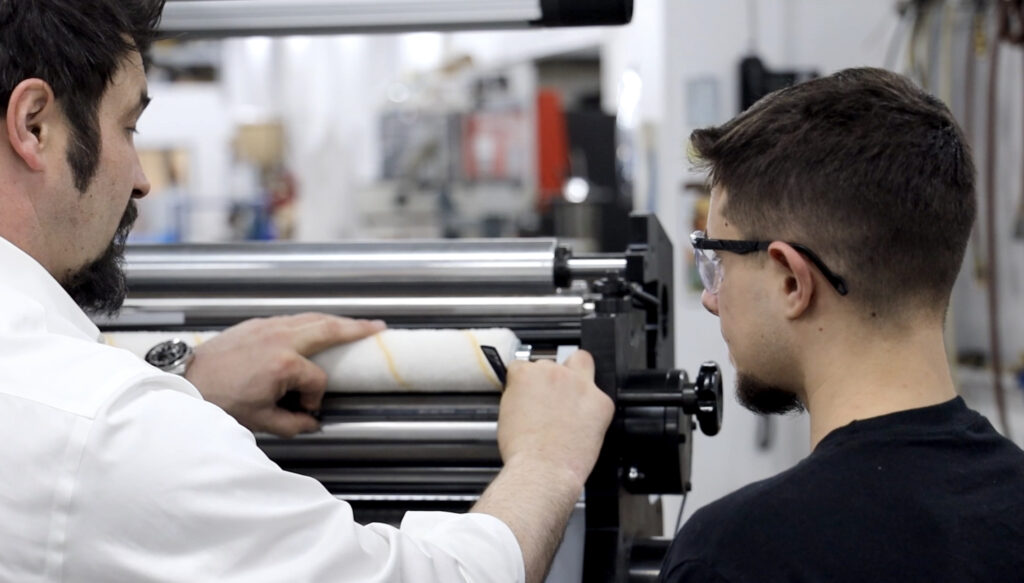Flexographic printing is the method of choice for many printers and converters, offering speed and flexibility to print on a wide range of substrates. Achieving high print quality requires special considerations for each type of substrate, whether printing on corrugated, film, flexible packaging, or other materials.
Troubleshooting Flexible Packaging Printing with a Flexo Press
When experiencing problems with flexo printing on flexible packaging, printers should first evaluate the top five most common problems:
-
-
- Ink Selection
- Ink pH
- Ink Viscosity
- Dirt and Contaminants
- Printing Plates
-
Ink Selection for Flexible Packaging
It is important to select the right type of ink when printing on flexible packaging that is compatible with the substrate material. Some materials used in flexible packaging or more tolerant of heat than others, and some exhibit better ink absorption. Ink selection should be based on specific substrate qualities.
Incorrect Ink pH Properties
There is a wide range of flexible packaging materials, whether paper, film, or aluminum and various composites such as polypropylene, polyester, polyethylene, and polyvinyl chloride. Varying pH levels are required for each type of material, with special characteristics required for proper adhesion, such as drying time.
Improper Ink Viscosity Levels
The viscosity of the selected ink is critical for quality printing results. If the viscosity does not match the material requirements, printers can experience smears, spotty deposits, uneven colors, foaming, trouble with abrasion, and other quality issues.
Dirt Deposits and Contaminants
Industrial settings where printing and converting is performed can create static electricity due to machinery operation, which can attract dust particles, ink particles, and other contaminants to accumulate on printing elements. Dirt and contaminants are the common culprits that affect flexible printing quality.
Printing Plates Set up and Maintenance
Flexible packaging materials have varying levels of thickness and may require different settings for printing plates to achieve the quality desired. Dirty, loose, worn, or soft plates could cause quality issues such as:
-
-
-
- Streaking
- Spotty printing
- Dirty and contaminated printing
- Image bleeding
- Washboard effects
-
-
Printers must maintain printing plates and sleeves properly and check the tension prior to every print run.
Improving Common Problems with Flexible Packaging Printing
All aspects of flexo printing on flexible packaging must come together perfectly to achieve high print quality. When experiencing poor quality printing on flex packaging could be due to a number of problems that cause improper ink drying time, cleanup issues, or other mishaps. Some tips to improve common problems with flexible packaging printing include:
-
-
-
-
- Adjust the Tension – always adjust the tension appropriately to maintain tight tension on the substrate, especially when stopping and starting.
- Perform Press Maintenance – always perform proper press maintenance, including a preventive maintenance program and specific work instructions for each print job. Maintenance should include checking the bearings, shafts, alignment, gear tips, plates, and printing pressure.
- Clean and lubricate gears – checking, cleaning, and lubricating gears regularly should be performed in addition to regular press preventive maintenance.
- Maintain Image Carrier Integrity – never use harsh cleaning solvents or agents in less specifically chosen for your image carrier to preserve the integrity.
- Choose the Right Type of Anilox – use the right type of anilox roller with cells to hold the appropriate amount of ink for the correct transfer rate. Evaluate the shape, cell count, and depth to achieve the correct volume for print design requirements.
- Choose Appropriate Distribution Method – be sure to use the proper carrier type, such as a sleeve, cylinder, or plate, for the best ink transfer to the flexible packaging material.
- Eliminate Contamination – check for leftover dried ink on the anilox roller, and be sure to maintain image carriers in top condition.
-
-
-
If experiencing issues when printing and converting on flexible packaging materials, speak with an experienced flexo press converting expert.
Tamarack® Products is recognized as an industry-leading provider of in-line and off-line web finishing solutions, experienced in flexo press printing and finishing. Tamarack® offers more than 50 years of experience in designing, engineering, and manufacturing specialty equipment for in-line flexo post-printing and other integrated labeling and finishing system solutions. Contact us to learn how to improve your flexo printing and finishing project on flexible packaging materials.





